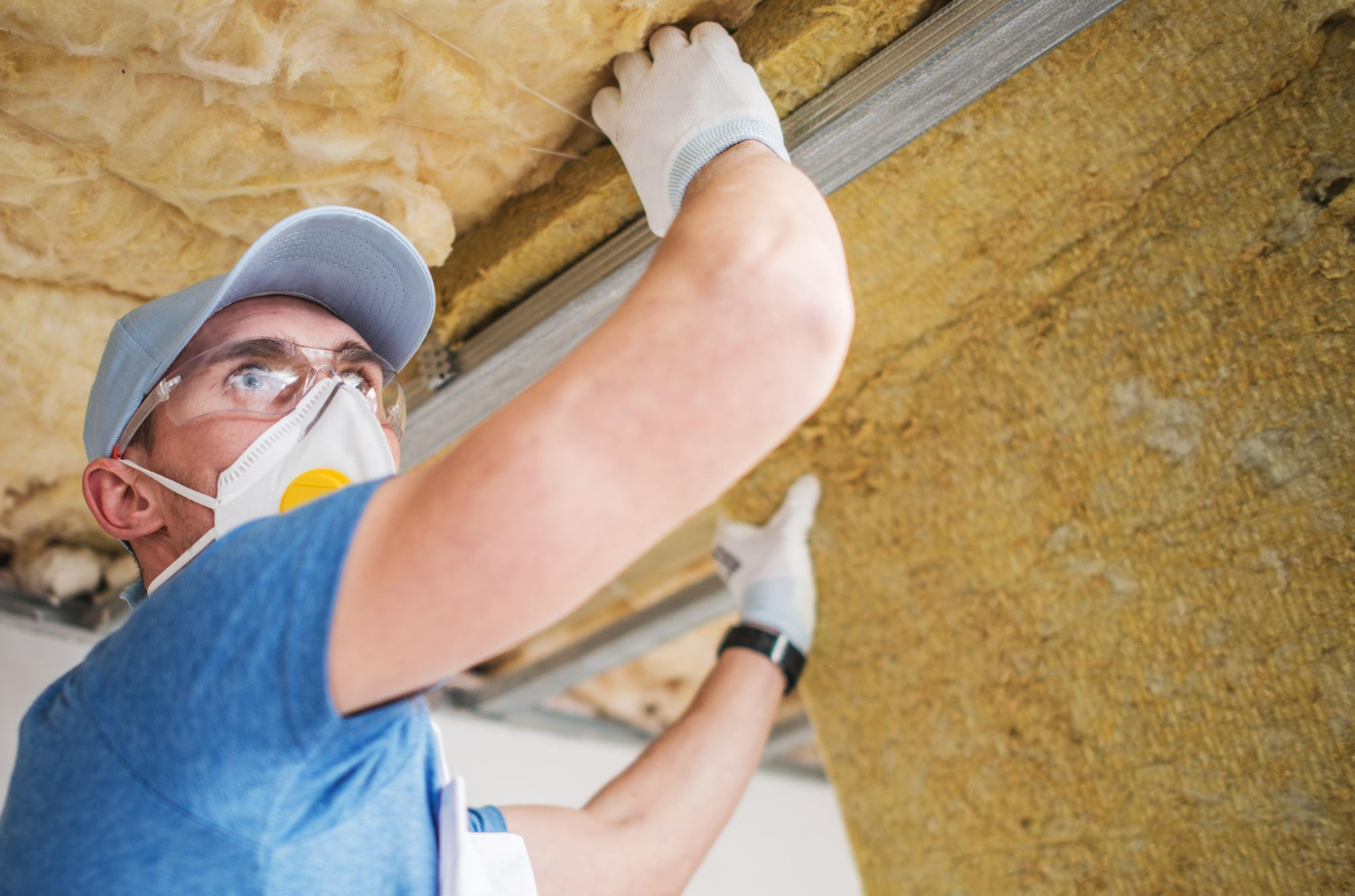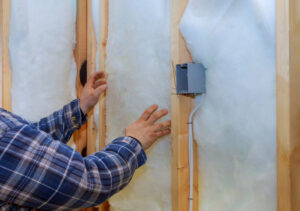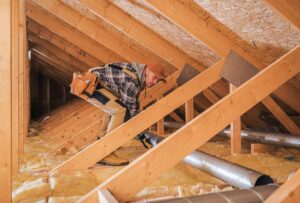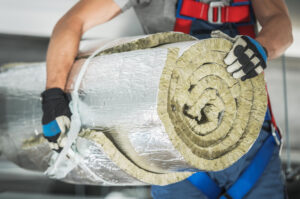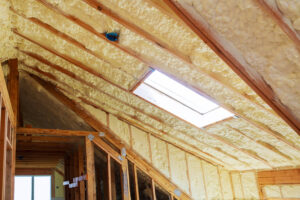As summer approaches, many homeowners struggle with rising temperatures and energy bills. While most people focus on air conditioning, home insulation is actually your secret weapon against the heat.
Good insulation will keep your home cooler during hot months and reduce energy costs by preventing cool air from escaping.
We often think of insulation as a winter solution, but it’s equally important during summer. Before temperatures soar, now is the perfect time to check your attic and wall insulation.
Simple improvements like sealing gaps around electrical boxes, adding weatherstripping to doors and windows, and ensuring proper attic ventilation can make a significant difference in your home’s comfort level.
Improving your home insulation doesn’t always require professional help or major renovations. Several quick and affordable DIY fixes can boost your home’s efficiency.
From using thermal curtains to block sunlight to adding reflective materials in your attic, these practical solutions help maintain comfortable indoor temperatures while reducing the strain on your cooling system.
In this article, you’ll discover practical strategies to improve comfort, reduce energy costs, and prepare your home for extreme summer heat.
Here’s what you need to know:
- Understanding the importance of proper summer insulation
- Key summer insulation hacks for immediate results
- Additional strategies for enhancing home comfort in summer
- Maintenance tips to extend insulation efficiency
Let’s dive in.
Understanding the importance of proper summer insulation
Proper insulation is often an overlooked component of home comfort during summer months. But, when installed correctly, insulation creates a thermal barrier that keeps cool air inside and hot air outside.
How insulation impacts energy efficiency
Insulation works as a barrier between your cool, air-conditioned home and the scorching summer heat. Without adequate home insulation, the hot air from outside easily penetrates your home, forcing your AC system to work harder and longer.
This increased workload not only strains your cooling system but significantly reduces its lifespan. According to home experts, proper attic insulation can reduce cooling costs by 10–50% depending on your current setup.
Insulation doesn’t just work in winter; it’s a year-round solution. When summer temperatures soar, well-insulated homes maintain more consistent indoor temperatures with less effort from air conditioning systems.
The benefits of effective insulation extend beyond comfort. A properly insulated home requires less energy to cool, which means:
- Reduced carbon footprint
- Lower utility bills
- Less strain on the power grid during peak summer times
To fully maximize these benefits, it’s important to also keep up with basic insulation repair and maintenance. Small gaps, compressed materials, or moisture damage can reduce insulation performance over time. Learn more about this in our article on the role of insulation in creating an energy-efficient home.
Before temperatures peak, inspecting and updating key zones like attics, exterior walls, and window seals can drastically improve your home’s energy efficiency.
The role of R-value and thermal resistance
R-value measures insulation’s ability to resist heat flow, the higher the R-value, the better the insulation performs. Different climate zones require different R-values for optimal performance.
For summer efficiency, focus on areas where heat enters most: attics, walls, and windows. The U.S. Department of Energy recommends R-values between R-30 and R-60 for attics in most regions, with higher values suggested for very hot climates.
Thermal resistance isn’t just about thickness. The type of home insulation you choose also impacts performance. Options include:
- Fiberglass: Common and affordable
- Cellulose: Eco-friendly with good R-value
- Spray foam: Highest R-value but more expensive
The right insulation type depends on your home’s construction, climate zone, and budget. In many cases, homeowners see the greatest returns by focusing on attic reinsulation, especially before peak summer hits. For a detailed look at why this strategy works, explore our guide on insulating your house before summer.
We recommend consulting professionals to determine the best R-value and insulation type for your specific situation.
Energy bills and summer energy costs
Every degree you raise your thermostat saves approximately 3–5% on cooling costs. With good insulation, you can set your thermostat higher while maintaining comfort.
The math is straightforward: A $200 monthly cooling bill could drop to $140–$160 with proper insulation improvements. These savings add up quickly, often paying for insulation upgrades within 2–5 years.
According to the U.S. Department of Energy, heating and cooling account for approximately 49% of energy use in U.S. homes, making insulation one of the most impactful upgrades for long-term savings.
Beyond immediate savings, you’ll benefit from:
- Reduced strain on your AC unit
- Fewer repairs and maintenance costs
- Longer HVAC system lifespan
- More consistent comfort throughout your home
For maximum savings, pair insulation upgrades with air sealing to prevent cool air from escaping through cracks and gaps.
Key summer insulation hacks for immediate results
Summer heat can dramatically increase your energy bills as your air conditioning works overtime. These proven home insulation techniques will help keep cool air in and hot air out when temperatures soar.
DIY air sealing and weatherstripping techniques
Start by inspecting doors and windows for gaps where cool air escapes. A simple test: hold a lit candle near edges and watch for flame movement indicating air leaks.
Apply weatherstripping to movable components like doors and windows. Self-adhesive foam strips are inexpensive and easy to install without special tools. Just clean surfaces, measure, cut to size, and press firmly in place.
Door draft excluders block heat at thresholds. You can buy adjustable models or make your own with fabric and rice or sand.
Caulk is perfect for sealing stationary gaps around window frames and baseboards. Choose silicone or acrylic caulk for long-lasting results. Clean the area first, apply in a continuous bead, and smooth with a wet finger.
Don’t forget electrical outlets on exterior walls. Special foam gaskets behind faceplates can prevent surprising amounts of air exchange.
If your current insulation setup is still struggling to keep your home cool, consider the value of reinsulating your attic to boost property value. This approach improves long-term efficiency and often increases resale appeal.
Maximizing attic insulation for heat protection
Attics can reach 150°F in summer, radiating heat downward through your ceiling. Now is the ideal time to check your attic home insulation before temperatures reach their peak.
Measure your existing insulation depth. In most climates, you want R-38 to R-60, which translates to 10–16 inches of typical fiberglass batts. If you have less, adding more will pay off quickly in energy savings.
Reflective barriers work wonders in hot climates. Attach reflective foil to rafters to bounce heat away from living spaces. This simple addition can reduce attic temperatures by up to 30°F.
Ensure soffit vents aren’t blocked by insulation. Proper ventilation prevents heat buildup while allowing moisture to escape. Insulation baffles maintain clear airflow while maximizing coverage.
Consider blown-in cellulose if adding to existing insulation. It fills gaps better than batts and provides better coverage around obstacles like junction boxes.
This type of upgrade is especially effective when paired with basic insulation maintenance practices like sealing air leaks and inspecting for moisture damage.
Upgrading with spray foam and rigid foam boards
For superior insulation performance, spray foam creates an airtight seal while providing excellent R-value. The expanding nature fills cracks and irregular spaces completely.
DIY spray foam kits are available for smaller projects. Always wear protective gear and follow manufacturer instructions precisely. Start with a test area before tackling larger spaces.
Rigid foam boards offer high R-values in thin profiles, making them perfect for areas with limited space. They come in different types: polyisocyanurate (highest R-value), extruded polystyrene (moisture resistant), and expanded polystyrene (most affordable).
Install rigid foam on basement walls, garage ceilings, or even exterior walls under siding during renovations. Cut boards with a utility knife and secure with adhesive or mechanical fasteners.
Create a thermal break by adding a layer of foam board to attic hatches or pull-down stairs. These often-overlooked areas can leak significant amounts of cool air into hot attic spaces, undermining the performance of your home insulation system. Regular checks in these areas are part of good insulation repair and maintenance practices.
Additional strategies for enhancing home comfort in summer
Beyond basic cooling methods, several effective strategies can make your home more comfortable during hot summer months without relying solely on air conditioning.
These approaches focus on smart use of existing features, targeted home insulation improvements, and simple modifications.
Leveraging ceiling fans and creating a cross-breeze
Ceiling fans are powerful tools for summer comfort when used correctly. Set your fans to rotate counter-clockwise during summer months. This direction pushes air straight down, creating a cooling wind-chill effect on your skin.
For maximum efficiency, keep fan blades clean and dust-free. Dirty blades reduce airflow and use more energy.
Creating a cross-breeze significantly enhances cooling. Open windows on opposite sides of your home, especially during cooler mornings and evenings. This natural ventilation technique pulls cool air through while pushing hot air out.
For best results, use window fans strategically. Place fans facing outward in upstairs windows to pull hot air out, while keeping downstairs windows open to draw in cooler air.
Improving insulation with fiberglass batt
Proper insulation isn’t just for winter; it’s for summer comfort too. Home insulation using fiberglass batt in attics and walls creates an effective barrier against heat transfer.
We recommend checking your attic insulation first. In summer, attics can reach 150°F, radiating heat downward into living spaces. Adding fiberglass batts between attic joists can reduce indoor temperatures by 10–15°F.
For walls with inadequate insulation, consider adding batts during any renovation project. The ideal R-value depends on your climate zone, but R-13 to R-23 is typical for exterior walls.
When installing, ensure batts fit snugly without compression. Wear protective gear including gloves, goggles, and a mask, as fiberglass particles can irritate skin and lungs. Whether you’re adding new material or replacing old batts, this simple home insulation project can make a noticeable difference in both temperature control and long-term energy savings.
Simple home improvement projects for better thermal performance
Several weekend projects can significantly improve your home’s summer performance. Installing weatherstripping around doors and windows prevents cool air leakage, a simple task costing under $50 per door.
Caulking gaps and cracks in your home’s exterior creates an additional barrier against heat infiltration. Focus on areas where different materials meet, like where siding connects to window frames.
Consider installing reflective window film on south and west-facing windows. This affordable upgrade blocks 70–80% of solar heat while still allowing natural light.
Adding attic ventilation through ridge vents or attic fans prevents heat buildup. A properly ventilated attic can be 30°F cooler than one without ventilation, directly impacting rooms below.
Smart landscaping provides natural cooling. Planting deciduous trees on the south and west sides of your home creates shade during summer while allowing warming sunlight in winter.
Many of these upgrades can be done independently, but for more extensive improvements, explore our insulation services designed for long-term efficiency. These solutions are tailored to boost thermal performance through expert evaluation and customized home insulation strategies.
Maintenance tips to extend insulation efficiency
Proper maintenance of your home insulation is essential for maximizing energy efficiency and comfort during summer months. Regular checks and timely repairs can prevent many common issues that reduce insulation effectiveness.
Inspecting and maintaining your insulation
Check your attic insulation at least twice a year, ideally in spring and fall. Look for any compression, water damage, or pest activity that might compromise its effectiveness. Use a ruler to measure the depth and ensure it meets the recommended R-value for your climate zone.
Clean vents and filters monthly during peak summer to maintain proper airflow. Dust and debris can block ventilation, forcing your cooling system to work harder.
Seal any new gaps around windows, doors, and utility penetrations with appropriate caulking or weatherstripping. Even small leaks can significantly reduce insulation performance.
If you have spray foam insulation, inspect for any cracks or separation from framing. These areas can be repaired with additional foam products designed for touch-ups. This kind of insulation repair and maintenance ensures that your system remains effective year-round.
Troubleshooting common issues
Moisture problems can seriously damage insulation. If you notice dampness, identify and fix the source immediately. This might include repairing roof leaks, improving ventilation, or addressing condensation issues.
For homes with inadequate insulation, consider adding insulation boosters in high-priority areas like attics. This can be more cost-effective than a complete replacement.
Check for thermal bridging where structural elements create paths for heat transfer. Apply targeted insulation solutions to these areas for improved efficiency.
If your home feels unevenly cooled, conduct a DIY thermal assessment using an infrared thermometer to identify problem areas. Focus your maintenance efforts on these spots first.
Be alert for unusual odors or visible mold in insulated areas. These indicate moisture problems that require immediate attention to prevent health issues and insulation degradation.
Conclusion
Staying cool in the summer doesn’t have to mean sky-high energy bills or overworked AC units. As we’ve seen, investing in proper home insulation, whether through quick DIY improvements or full-scale upgrade, can make a major difference in your home’s efficiency, comfort, and long-term savings.
From sealing air leaks to enhancing attic protection and choosing the right R-value, small actions today can lead to measurable results all season long. Even basic insulation maintenance helps preserve performance and prevent costly problems down the line.
If you’re ready to reduce heat, cut costs, and create a more livable space this summer, insulation is the smartest place to start. Need help planning your next insulation upgrade? Explore your options with Terra and take the first step toward a cooler, more efficient home.

